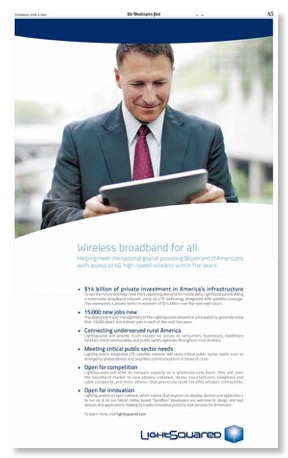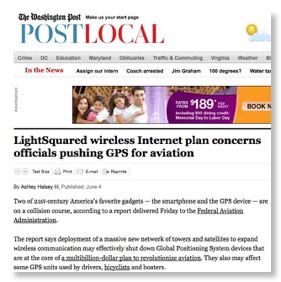LightSquared/GPS:
The Craziness Continues on Both Sides
16 06, 11 12:10 Filed in: GPS
The GPS/LightSquared issue gets more and more bizarre. Many of us used to think that law firms were taking too big a role in such technical policy issues, now it looks like PR firms are calling the shots! At left is an article from last weekend’s Washington Post, no doubt planted by the GPS community’s PR firm, Prism Public Affairs. The author normally writes about aviation and transportation issues, not FCC or spectrum issues.
The article describes the May 26th RTCA Executive Summary of a report entitled “Assessment of the LightSquared Ancillary Terrestrial Component Radio Frequency Interference Impact on GNSS L1 Band Airborne Receiver Operation”. RTCA describes itself as “a private, not-for-profit corporation that develops consensus-based recommendations regarding communications, navigation, surveillance, and air traffic management (CNS/ATM) system issues.” It is also an advisory committee to FAA. (I believe that in ancient history is was an advisory committee to both FCC and FAA.)
While the study concludes that LightSquared use of 1526.3 –1531.3 MHz “is compatible with aviation GPS operations for all the representative scenarios” - a point omitted in the PR-driven Post article, the study “ concludes that the current LightSquared terrestrial authorization would be incompatible with the current aviation use of GPS, however modifications could be made to allow the LightSquared system to co-exist with aviation use of GPS”.
Rather than filing this report in the FCC docket, RTCA is selling it for $150! So if you want to know how they reached this conclusion, you have to “pay to play”.
Since LightSquared has never publicly described their antenna pattern or antenna siting rules, one can only assume that RTCA, like Garmin, just assumed a 33 dBw isotropic radiator - that is, an antenna radiating about 1500W in all directions. Now neglecting the fact that it is impossible to build such an antenna in the real world, nobody uses anything near isotropic antennas in the mobile radio world and the 33 dBw was clearly intended as the maximum eirp in any direction, not the typical eirp.
So RTCA could not wait until the completion of the joint receiver testing to blast its own conclusions based on incomplete information on LightSquared’s actual antennas.
 But as shown at right, LightSquared is showing that it can avoid the technical issues also and focus on PR. Several days last week they had full page ads in the Post extolling the benefits of their system: “Wireless broadband for all”, “15,000 new jobs”, “Connecting underserved rural America”, etc. Never mentioning that there was a serious technical spectrum controversy underway, indeed one of the most complex spectrum issues in that past decade. So like the GPS community, they are investing heavily in PR when perhaps they should be focusing more on the technical issues at hand.
But as shown at right, LightSquared is showing that it can avoid the technical issues also and focus on PR. Several days last week they had full page ads in the Post extolling the benefits of their system: “Wireless broadband for all”, “15,000 new jobs”, “Connecting underserved rural America”, etc. Never mentioning that there was a serious technical spectrum controversy underway, indeed one of the most complex spectrum issues in that past decade. So like the GPS community, they are investing heavily in PR when perhaps they should be focusing more on the technical issues at hand.
Both FCC and NTIA have technical advisory committees that could be used to review some of the technical issues involved. But both the FCC’s TAC and NTIA’s CSMAC seem to be mainly composed of vested interests in major telecom companies with a few public interest folks thrown in, not the distinguished members one sees on the Defense Science Board or the Air Force Scientific Advisory Board, not to mention NRC’s Advisory Committee on Reactor Safeguards. Furthermore, NTIA’s testing of GPS receivers certainly must have included military units whose performance is of necessity classified. CSMAC is not set up to deal with classified information although it certainly should not come as a surprise that some NTIA regulated systems have classified performance data.
But more importantly, neither FCC nor NTIA have ever tried to ask their technical advisory committees for information on ongoing policy issues like other technical regulatory agencies do. These were issues raised in the IEEE-USA June 2008 letter to Chmn. Martin that was never answered. Maybe it is time for FCC and NTIA to review their resources for dealing with difficult spectrum problems such as this one.
The article describes the May 26th RTCA Executive Summary of a report entitled “Assessment of the LightSquared Ancillary Terrestrial Component Radio Frequency Interference Impact on GNSS L1 Band Airborne Receiver Operation”. RTCA describes itself as “a private, not-for-profit corporation that develops consensus-based recommendations regarding communications, navigation, surveillance, and air traffic management (CNS/ATM) system issues.” It is also an advisory committee to FAA. (I believe that in ancient history is was an advisory committee to both FCC and FAA.)
While the study concludes that LightSquared use of 1526.3 –1531.3 MHz “is compatible with aviation GPS operations for all the representative scenarios” - a point omitted in the PR-driven Post article, the study “ concludes that the current LightSquared terrestrial authorization would be incompatible with the current aviation use of GPS, however modifications could be made to allow the LightSquared system to co-exist with aviation use of GPS”.
Rather than filing this report in the FCC docket, RTCA is selling it for $150! So if you want to know how they reached this conclusion, you have to “pay to play”.
Since LightSquared has never publicly described their antenna pattern or antenna siting rules, one can only assume that RTCA, like Garmin, just assumed a 33 dBw isotropic radiator - that is, an antenna radiating about 1500W in all directions. Now neglecting the fact that it is impossible to build such an antenna in the real world, nobody uses anything near isotropic antennas in the mobile radio world and the 33 dBw was clearly intended as the maximum eirp in any direction, not the typical eirp.
So RTCA could not wait until the completion of the joint receiver testing to blast its own conclusions based on incomplete information on LightSquared’s actual antennas.

Both FCC and NTIA have technical advisory committees that could be used to review some of the technical issues involved. But both the FCC’s TAC and NTIA’s CSMAC seem to be mainly composed of vested interests in major telecom companies with a few public interest folks thrown in, not the distinguished members one sees on the Defense Science Board or the Air Force Scientific Advisory Board, not to mention NRC’s Advisory Committee on Reactor Safeguards. Furthermore, NTIA’s testing of GPS receivers certainly must have included military units whose performance is of necessity classified. CSMAC is not set up to deal with classified information although it certainly should not come as a surprise that some NTIA regulated systems have classified performance data.
But more importantly, neither FCC nor NTIA have ever tried to ask their technical advisory committees for information on ongoing policy issues like other technical regulatory agencies do. These were issues raised in the IEEE-USA June 2008 letter to Chmn. Martin that was never answered. Maybe it is time for FCC and NTIA to review their resources for dealing with difficult spectrum problems such as this one.
blog comments powered by Disqus




![Validate my RSS feed [Valid RSS]](valid-rss-rogers.png)

